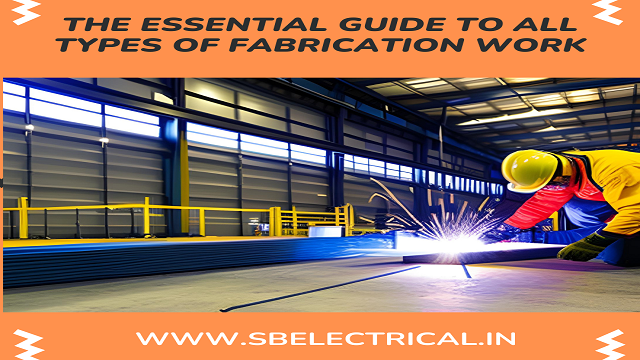
- March 31, 2023
- By sbelectricaladmin
- Electrical Services
Many economic sectors, including engineering, manufacturing, and construction, depending on fabrication, the process of turning raw materials into finished products. if you take a closer look at the term fabrication, you will notice that there are several types of fabrications. For instance, welding, machining, casting, and molding, each with advantages and disadvantages.
Your understanding of the various fabrication task types and the tools, techniques, and materials used are the key objectives of this tutorial. This tutorial includes something for everyone, whether you’re a novice looking to learn more about fabrication or an expert hoping to increase your expertise.
Join us as we investigate the realm of fabrication and learn how the things and buildings we depend on every day are made.
All types of Fabrication Work
Fabrication, which comprises a variety of methods and procedures, is the method used to modify raw materials into completed goods. Mentioned below are all types of fabrication that you should know about.
- Welding: Welding is the process of fusing two or more metal components together with heat. The construction, industrial, and automotive industries all adopt this method.
- Machining: Machining involves removing material from a workpiece using cutting tools. This process is used to create parts for machines, engines, and other mechanical devices.
- Casting: Casting involves pouring liquid metal or plastic into a mold to create a specific shape. This process is commonly used in the production of automobile parts, aerospace components, and jewelry.
- Forming: Forming involves shaping metal or plastic into a desired shape using tools such as a press brake or hydraulic press. This process is used to create components for machinery and equipment.
- Extrusion: Extrusion involves pushing material through a die to create a specific shape. This process is commonly used to produce plastic tubing, aluminum profiles, and rubber seals.
- Sheet Metal Fabrication: Sheet metal fabrication involves cutting, bending, and shaping sheet metal into a specific shape. This process is used to create various components for machinery, including enclosures and panels.
- 3D Printing: 3D printing involves using a printer to create a three-dimensional object from a digital model. This process is used to create prototypes, custom parts, and components for various industries.
- Powder Coating: Powder coating involves applying powdered paint to a metal surface and curing it to create a durable finish. This process is used to protect metal components from corrosion and wear.
- Laser Cutting: Laser cutting involves using a high-powered laser to cut or engrave a material. This process is used to create custom parts and components for machinery and equipment.
In the end!!
To sum up, fabrication is an essential process that turns raw materials into completed goods utilized in many different industries, such as engineering, manufacturing, and construction. Each of the various fabrication processes, such as welding, machining, casting, forming, or others, has its special tools, techniques, and materials.
These criteria must be carefully taken into account to select the best manufacturing technique for a given project. Fabrication continues to develop as a result of technological and material advances, enabling more accurate and efficient product creation. Understanding the various sorts of fabrication work will help you make wise choices when it comes to designing or producing things, whether you’re a novice or an experienced professional. We hope that this indispensable book has given you insightful knowledge about the fabrication industry and its many applications.
SB Electrical is one of the most popular companies offering the best fabrication in NCR. If you wish to know more about the services, get in touch with us now.